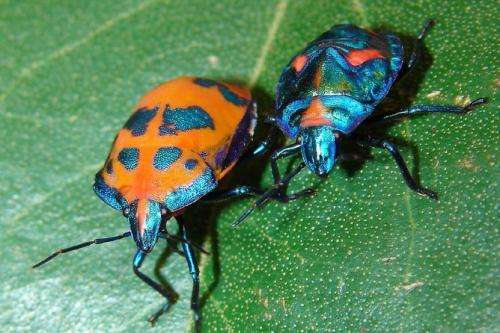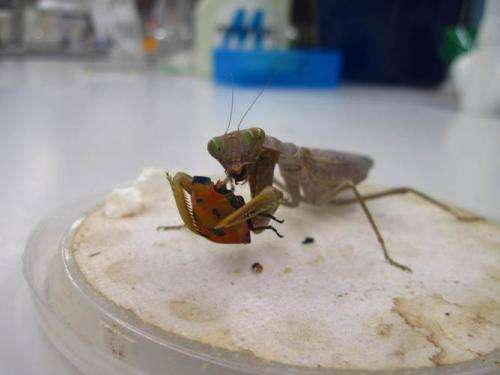To avoid mantids, stinkbugs evolved to hide in plain sight

Did you know that the sky isn't actually blue? Perhaps in school you learned about how air scatters light, filtering out red light from the sun, but that is only half the story. While our eyes perceive a milky blue, a more optically-endowed creature, such as a bird, would actually see a colour which is more of a violet, pushing into ultraviolet. That milky blue happens in our eyes.
Inside your eyes are light-sensitive cells called photoreceptors. There are four types – rods for black and white vision, and three cones for colour. These cones absorb light in different parts of the visible spectrum, and are maximally sensitive to blue, green, or red light. The light isn't really that colour, but our brain perceives different input from our three cones and translates it into every slice of the rainbow.
But humans can't see ultraviolet light. In fact, our perception of even the colour violet is not so great, so pale violet sky appears milky blue.
In a recent study, researchers from Macquarie University, including myself, showed that Harlequin bugs, which are bright orange, play a surprising trick – they simultaneously exploit both limited colour vision and picky eating habits in their predators.
Insect vision
Many other animals are capable of seeing the sky in its full ultraviolet glory. Birds for example have four colour receptors, UV through red, and are capable of viewing the world with a richness of colour we can't even imagine.
But much like humans, most insects also have limited colour vision, but in a different way than ours. They have ultraviolet sensitivity, but not sensitivity to reds and oranges.

The praying mantids go a step further sacrificing colour vision altogether for other visual skills. This adept insect predator has keen motion-sensitive vision and lightning-quick reflexes to snatch flying prey. Some are masters of disguise. Others have the ability to lure bees with their orchid-like appearance.
The cost of their excellent motion-capture vision is colourblindness. They only have one type of photoreceptor, which is highly sensitive to green and can detect light from ultraviolet through orange. This makes sense for the mantis, because it is usually hunting against the backdrop of green foliage or perhaps the violet sky. Seeing red just isn't that useful for this stoic hunter.
Why, then, if insects are so poor at seeing red, are ladybirds such vibrant scarlet? The ladybirds are advertising, but not to each other. The red colouration is a warning to any large red-sensitive predator, typically birds. They are poisonous, and release a foul ooze if disturbed.
Most tasty grubs have evolved to be well camouflaged, minimising risk of attack. Instead, well-defended ladybirds have more to gain by advertising their defences and avoiding any attacks at all. This is known as "aposematism". The phenomenon is found across the animal kingdom, from blue-ring octopus to poison dart frogs, but is most well-known and well-studied among the insects.
Hiding in plain sight
One such insect is a most beautiful stinkbug. The Harlequin Bug, a shield-back stinkbug, is vivid orange, and has iridescent green patches on its back. You wouldn't fail to spot it hanging out on a leaf, and neither do birds. Despite being fairly mild by stinkbug standards, birds abhor the taste and avoid the bugs.
Mantids, on the other hand, are not so picky, and will happily gobble harlequin bugs by the clawful. This doesn't bode well for the stinkbug, and it needs to find a solution to stop being preyed upon by mantids.
In the tropics, where mantids are plentiful, the bugs are a pale orange and few have those eye-catching metallic patches. Down south where birds are the primary terror, their orange is richer and patches larger. Was this just an artefact of the climate, or real adaptation? To test this, we put mantids up to the challenge.
In the experiment, mantids were given a forking branch with leaves at the end. Pinned to each leaf was a wriggling bug, one pale orange with no patches, the other dark orange with big patches. As we predicted, mantids were drawn to the shinier bugs. But the real surprise happened when we paired an orange bug against an unoccupied leaf. At greater than 30cm distance, the mantids couldn't even tell the wriggling bug was there.
The bugs were not invisible. Indeed, darker orange bugs were more visible. Instead, the bugs had evolved to tweak their shade of orange to look exactly like the green leaves to the mantids' eyes. Because mantids can't distinguish colours, brightness is what matters. Even for insect predators that can see colour, anything more red than yellow is also a question of brightness, and bright orange looks just like a dull green leaf to them too.
In this way, the bugs could be camouflaged to mantids while still advertising their defences to birds.
Source: The Conversation
This story is published courtesy of The Conversation (under Creative Commons-Attribution/No derivatives).![]()




















